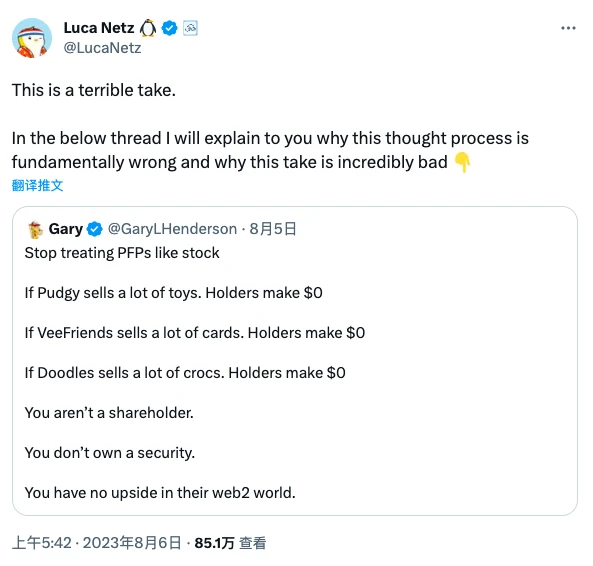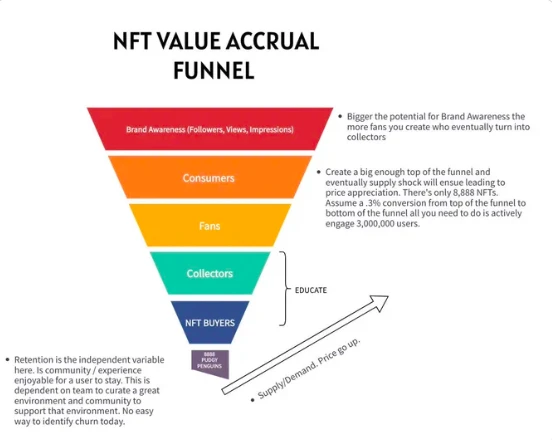"Fat Penguin" CEO's Handwritten Essay: Six Key Points for NFT Development
Author: Luca Netz
Compiled by: Odaily Planet Daily
On August 5, Twitter KOL Gary posted that investors should realize that the commercial expansion of PFP NFTs will only help project parties generate revenue, but will not bring any benefits to holders, and therefore PFPs should not be viewed as stocks.
In response, Luca Netz, CEO of the NFT project "Pudgy Penguins," published a lengthy article to refute this claim. In the article, Luca Netz systematically elaborates on the importance of brand commercialization for the development of NFT projects from six aspects, including explaining how revenue will ultimately flow to NFT holders through a "funnel" model, and discussing why some blue-chip NFT projects gradually approach zero in value in relation to supply and demand.

As one of the standout NFT projects during the bear market, since Luca Netz took over the project in February last year, "Pudgy Penguins" has not only emerged from historical gloom but also reached a historical peak in ETH value while other PFP projects continued to decline. As a result, Luca Netz's reputation in the NFT industry has continued to rise, with many project parties viewing him as a role model, hoping to replicate the success of "Pudgy Penguins" through imitation and learning from his operations.
Considering that Luca Netz has detailed his thoughts on NFT development in this recent article, the content may hold certain reference value for practitioners in the same field. Below is the original text by Luca Netz, compiled by Odaily Weekly.

Gary's viewpoint is very poor.
In the following text, I will explain to you why this way of thinking is fundamentally wrong and why this viewpoint is very poor.
To clearly articulate my perspective, I will list six key points that directly support "why building a globally recognized brand is the best way to accumulate value for NFT holders."
Key Point 1: Marketing
NFTs are a limited resource, and as interest and demand grow, the NFTs you hold will naturally accumulate value.
NFTs need to succeed through marketing. Everyone wants instant value conversion; however, this is impossible during a deep bear market. When NFTs are in a hype phase, some announcements may trigger huge interest and demand, ultimately accumulating significant value for NFTs, but if it were today, the same measures might not be as effective.
Is it only NFTs that are like this? No. Many excellent Layer 2 projects are releasing significant announcements that could have rapidly increased project valuations two years ago, but today, the same important announcements hardly impact the secondary market.
In a bear market, every asset class shares the same characteristics; we are not an exception.
As shown in the funnel model below, marketing can amplify the top of the funnel, which is also the starting point for the accumulation of NFT demand and value. Over time, value will gradually flow down the funnel from the top, ultimately reaching NFT holders.

Key Point 2: Emotional Connection
Before we begin, there is a piece of data worth citing about collectibles. To date, the total size of the global collectibles market has reached $426 billion, and this market is built not on liquidity or instant dopamine release, but on emotional connections.
To increase the value of your NFT, you need to optimize two things:
First is demand, which can be achieved by implementing various marketing activities to gradually raise project awareness.
Second is holding, which is driven by emotional connections. This includes emotional connections with community members as well as with interactive experiences, content, and characters. If we can establish sufficient emotional connections between holders and NFTs, the value of emotions will ultimately surpass monetary gains, making it priceless.
If you can create enough demand and have sufficiently appealing emotional connections, you can create the best value appreciation mechanism in the world.
Look at the scene below. If you see your child reacting this way to a "Pudgy Penguin" toy, would you sell it and rush to other shitcoins? Wouldn't this reaction make you more confident that the project is building its long-term vision?

Key Point 3: Sustainability
This point is often the most overlooked.
Understanding sustainability helps you grasp what has killed your favorite blue-chip projects during 2020-2021, and the answer lies in "dilution." "Dilution" arises when a project cannot generate external revenue, ultimately leading them to issue more NFTs.
Unfortunately, when the growth of demand cannot match the growth of supply, the ecosystem tends to approach zero.
Creating a sustainable brand can effectively reduce the greatest risk of holding NFTs—unnecessary "dilution" to maintain and advance the business.
Demand > Supply = NFT value rises;
Supply > Demand = NFT approaches zero.
Establish a sustainable revenue model -> Invest in marketing -> Create more demand -> NFT value growth.
This is not difficult to understand.
Key Point 4: Touchpoints
Essentially, this is just a foundational task, but I believe that if you can create enough touchpoints (opportunities for users to engage with the project IP), this will translate into the greatest upward momentum when market conditions improve.
Let’s take Pudgy Toys as an example. I often hear doubts about Pudgy Toys: "Luca, no one will buy your toys and then go buy your NFTs; what’s the benefit for holders?"
That's true; today they won't, but I don't need them to do so right now. However, when the NFT bull market returns and traders start building their collections, which NFTs do you think they are most likely to buy? I believe they are most likely to choose those NFTs they see most often, and once they have ample funds, they will purchase them.
More brand collaborations, more products and content—these are all excellent ways to create more touchpoints.
Key Point 5: Experiences
Within the NFT culture, everyone craves various free benefits, but unfortunately, as royalties diminish, these are no longer sustainable.
If I cannot create real external cash flow by building a successful brand, I cannot create more and better experiences for holders without "diluting" their interests. But if I can establish a successful brand that can supplement the treasury with continuous revenue, I can use these reserves to provide more and better experiences for the community.
The entire value transfer process is as follows:
- Create free memorable experiences for holders -> Non-holders experience FOMO -> They want to participate -> They buy NFTs -> NFT value rises -> Holder interests grow.
Key Point 6: Institutional Game
It is evident to me that 90% of NFT traders do not understand what is happening in this field and where the real upside potential lies.
This is both an institutional game and a retail game; if you think the 150 ETH floor of BAYC is driven by retail demand, then you are clearly mistaken.
What most people do not know is that the world's largest funds are making huge investments in intellectual property. Intellectual property is a good tool to resist economic recession cycles and has proven to be a great asset class for funds to diversify their investments.
You need to ask yourself how your project can attract those funds that are currently or in the future seeking to incorporate NFTs into their next-generation intellectual property portfolios. Do you really think game theory and Ponzi economics will excite institutional capital? If you think so, then you do not understand the true potential of these assets and this game.
Attracting arbitrageurs = short-term success;
Attracting institutions = long-term success.
In my view, in the future, those funds will look for Web 3 IP that can meet existing intellectual property demands and utilize blockchain technology to create new models.
Attracting one institution is far better than attracting 500 arbitrageurs.
Conclusion
I know these arguments may seem biased because I am defending my own position, but you must remember that we purchased "Pudgy Penguins" for $2.5 million, and our sole purpose in acquiring this project is to be number one and set a benchmark in the NFT field.
With this in mind, we spent many months critically thinking about how to take the best approach to achieve this goal. Ultimately, this is the conclusion we reached.
If what you want is a Ponzi shitcoin, then go launch a better one.
If you want to be part of the new era of culture, community, and intellectual property, then NFTs are your battlefield.
The reason for publishing this article is to refute the claim that "brand commercialization does not benefit NFT holders." I believe that over time, the NFT field will realize that this is the right way to incubate the next generation of NFTs.











